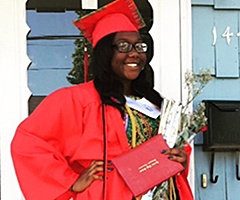
Amaodo's Story
Amaodo, age 17, had a history of asthma, so the trouble she was having with her breathing didn't alarm her — at first. But last fall, when the symptoms became worse, she went to her doctor. She was diagnosed with a rare disorder that causes weakness of the skeletal muscles.
In Amaodo's case, the muscles she uses for breathing were seriously impaired, resulting in potentially life-threatening respiratory failure. Amaodo was hospitalized and put on a ventilator to help her breathe. A breathing tube was inserted through her mouth into her wind pipe, making it impossible to speak. But that wasn't the worst part. Breathing tubes are typically extremely painful, and patients are usually given pain medications to help them tolerate the discomfort. But not Amaodo. She chose to withstand the pain, in order to avoid any additional risks from the drugs.
"I was on a breathing tube for 16 days," recalls Amaodo. "It was horrible and painful. I try not to remember it."
As they do for all pediatric patients at Yale New Haven Children's Hospital, the artists-in-residence, art therapists and volunteers of the Arts for Healing unit stepped in to help.
Arts for Healing provides art therapy, music therapy and creative activities to help children and their families cope with the traumas of illness and hospitalization. No one would choose to be in the hospital, but it's particularly tough for kids. The unfamiliar environment, painful medical procedures, and isolation can be depressing.
Often, they start to feel like "just a bundle of pain, a list of symptoms. You no longer feel like a person," says Kendra Carlson, ATR, a registered art therapist who works with the program.
There are a range of Arts for Healing activities to provide creative outlets, teach coping skills and — perhaps most important — help kids take their mind off pain. Regularly scheduled group activities like painting, drum circle, and wood crafts are offered every day to patients and their caregivers. And for those who aren't up to participating in a group setting, other activities like poetry, music, video arts or art therapy can be brought to the bedside.
When Amaodo first arrived, she didn't feel like participating, "because I was depressed and so unhappy to be in the hospital."
But eventually, she decided to give it a try. She hoped it might take her mind off her treatment. Amaodo worked with the writer-in-residence, the video artist, and with art therapist Kendra Carlson to create a variety of projects that allowed her to express all the emotions that were bottled up inside her — depression, pain, gratitude to her caregivers, and eventually, her pride in the strength she found to cope with so much adversity.
"I was happy when the artists came," she says. "They got my mind off of my pain and the other stuff in the hospital. It gave me something to look forward to. It helped me keep my spirits up."
Kendra, who worked with Amaodo on her digital art piece, certainly saw the positive impact: "One of the wonderful, therapeutic things that occurred was that the creative process enabled her to block out her surroundings, ground herself, and express her traumatic experience and how she felt about it. It was amazing to witness."
Amaodo, back in good health today, has just started her freshman year at UConn, where she is studying for a medical career. "I want to be a pediatrician or a nurse practitioner. I want to help kids like me."


